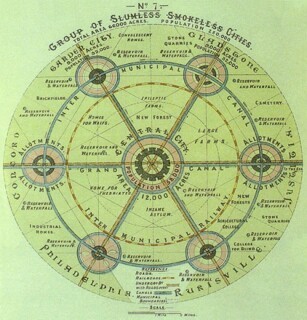Looking Backward
Gillian Darley · Garden Cities
David Cameron has been playing fast and loose with the term ‘Garden City’, almost as if he didn’t know that its origins lie in Victorian utopian socialism. The First Garden City (that is, Letchworth) was the realisation of ideas that Ebenezer Howard had set out in a small book in 1898, Tomorrow: a Peaceful Path to Real Reform, reissued in 1902 as Garden Cities of Tomorrow. The following year Letchworth Garden City began to take shape, about thirty miles north of London. Every citizen who came to First Garden City Ltd was a shareholder; everyone in town was to be a part-owner of a large and valuable estate. One of the first investors was George Bernard Shaw.
Howard, born in London in 1850, spent a few years in the 1870s working as a court reporter in Chicago. He returned to late Victorian London concerned to separate industrial zones from housing areas, and his blueprint separated new clean manufacturing from salubrious affordable homes (and gardens), a full range of amenities as well as generous open space, allotments and smallholdings, public parks and more. Howard looked back to all sorts of mid-19th-century visionary ventures, as well as William Morris’s News from Nowhere and Edward Bellamy’s novel Looking Backward: 2000-1887 – set in a future Boston that’s a model of social and economic co-operation.
Among the first industries to arrive were printing, publishing and bookbinding, mineral water bottling and an American corset-maker, Spirella. The houses were the best that could be provided on a limited budget and the Cheap Cottages Exhibition was a highlight of 1905. But most important of all was the idea that the town as a whole, rather than individual landowners, should benefit from the rise in land value. Cameron has a surprise in store if that's really the kind of development he has in mind.

Comments